进化论英文介绍
- 格式:ppt
- 大小:2.54 MB
- 文档页数:45

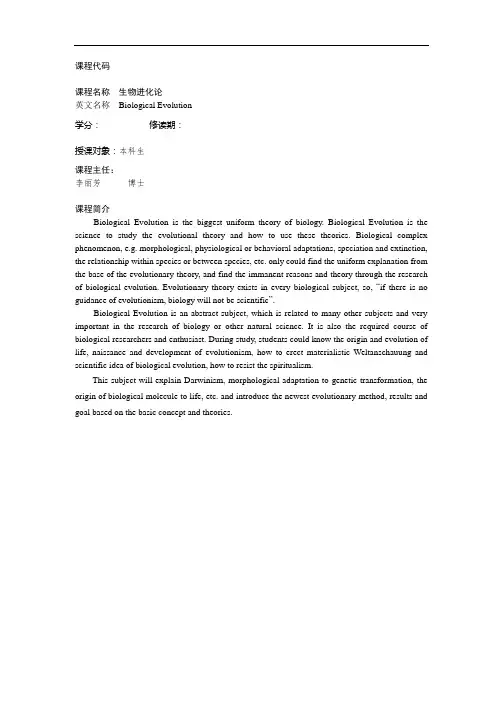
课程代码课程名称生物进化论英文名称Biological Evolution学分:修读期:授课对象:本科生课程主任:李丽芳博士课程简介Biological Evolution is the biggest uniform theory of biology. Biological Evolution is the science to study the evolutional theory and how to use these theories. Biological complex phenomenon, e.g. morphological, physiological or behavioral adaptations, speciation and extinction, the relationship within species or between species, etc. only could find the uniform explanation from the base of the evolutionary theory, and find the immanent reasons and theory through the research of biological evolution. Evolutionary theory exists in every biological subject, so, “if there is no guidance of evolutionism, biology will not be scientific”.Biological Evolution is an abstract subject, which is related to many other subjects and very important in the research of biology or other natural science. It is also the required course of biological researchers and enthusiast. During study, students could know the origin and evolution of life, naissance and development of evolutionism, how to erect materialistic Weltanschauung and scientific idea of biological evolution, how to resist the spiritualism.This subject will explain Darwinism, morphological adaptation to genetic transformation, the origin of biological molecule to life, etc. and introduce the newest evolutionary method, results and goal based on the basic concept and theories.。
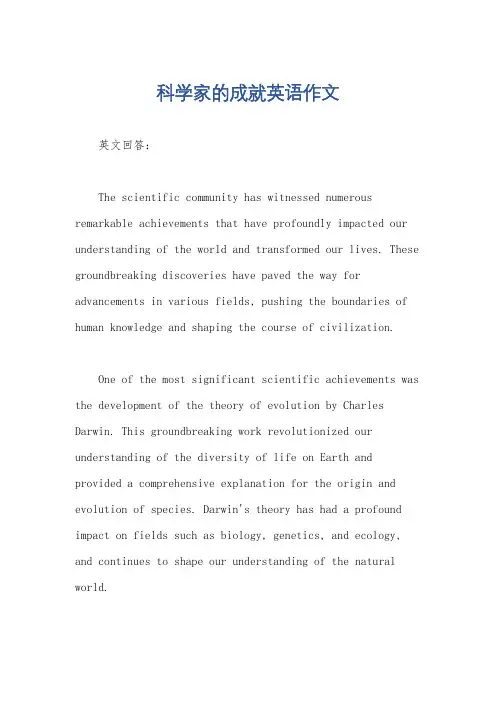
科学家的成就英语作文英文回答:The scientific community has witnessed numerous remarkable achievements that have profoundly impacted our understanding of the world and transformed our lives. These groundbreaking discoveries have paved the way for advancements in various fields, pushing the boundaries of human knowledge and shaping the course of civilization.One of the most significant scientific achievements was the development of the theory of evolution by Charles Darwin. This groundbreaking work revolutionized our understanding of the diversity of life on Earth and provided a comprehensive explanation for the origin and evolution of species. Darwin's theory has had a profound impact on fields such as biology, genetics, and ecology, and continues to shape our understanding of the natural world.Another notable achievement was the discovery of the structure of DNA by James Watson and Francis Crick in 1953. This breakthrough provided fundamental insights into the genetic basis of life and paved the way for advances in genetics, biotechnology, and medicine. The discovery has led to the development of groundbreaking technologies such as genetic engineering and gene therapy, with immense potential for improving human health and well-being.The advent of modern medicine has also been marked by significant scientific achievements. The discovery of antibiotics in the 20th century transformed the treatment of infectious diseases, dramatically reducing mortality rates and improving global health outcomes. Advances in medical imaging technologies, such as X-rays, MRI, and CT scans, have greatly enhanced our ability to diagnose and treat a wide range of medical conditions.In the realm of technology, the invention of the transistor in the mid-20th century laid the foundation for the rapid development of electronics and computer technology. The advent of integrated circuits andmicroprocessors led to the creation of personal computers, smartphones, and other electronic devices that have become indispensable in our daily lives. These advancements have revolutionized the way we communicate, access information, and conduct business, transforming the global economy and our daily routines.The exploration of space has also been marked by historic scientific achievements. The launch of artificial satellites and human spaceflight missions has provided invaluable insights into our solar system and the wider universe, expanding our knowledge of astronomy, astrophysics, and planetary science. These missions have also paved the way for technological advancements such as satellite communications and remote sensing, which have practical applications in fields such as weather forecasting, navigation, and environmental monitoring.中文回答:科学界见证了众多杰出的成就,这些成就对我们对世界的理解产生了深远的影响,并改变了我们的生活。
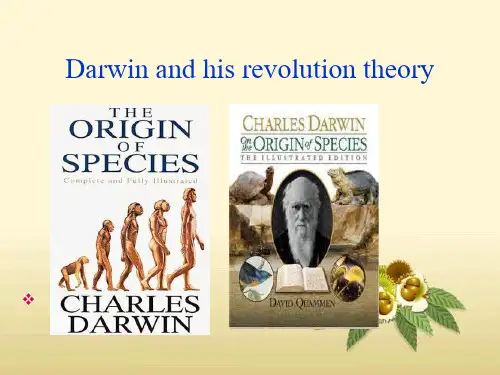
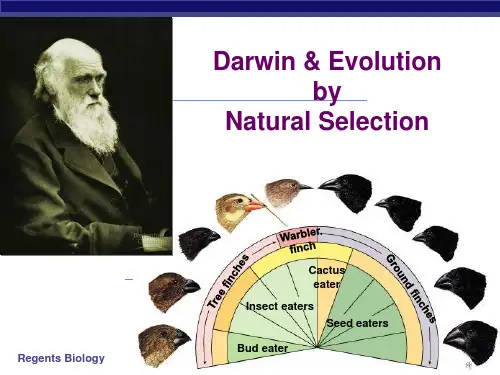
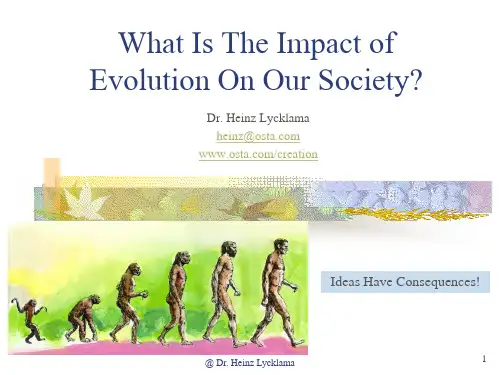
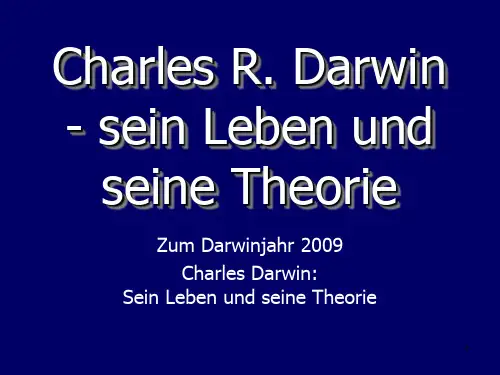
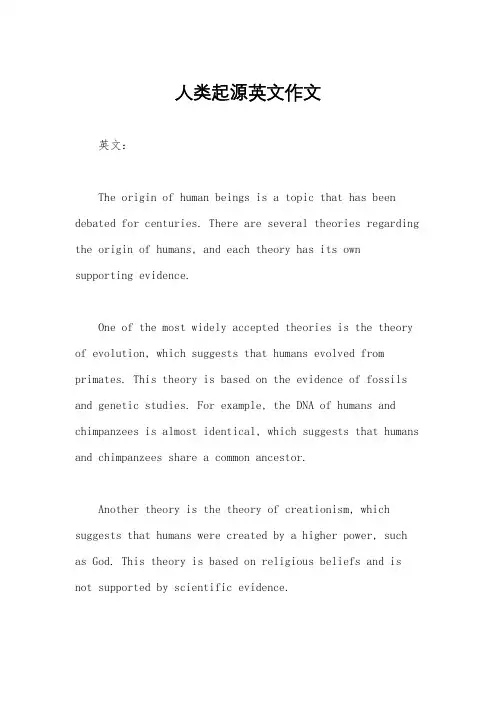
人类起源英文作文英文:The origin of human beings is a topic that has been debated for centuries. There are several theories regarding the origin of humans, and each theory has its own supporting evidence.One of the most widely accepted theories is the theory of evolution, which suggests that humans evolved from primates. This theory is based on the evidence of fossils and genetic studies. For example, the DNA of humans and chimpanzees is almost identical, which suggests that humans and chimpanzees share a common ancestor.Another theory is the theory of creationism, which suggests that humans were created by a higher power, such as God. This theory is based on religious beliefs and is not supported by scientific evidence.Personally, I believe in the theory of evolution. I think that the evidence supporting this theory is more convincing than the evidence supporting creationism. However, I respect the beliefs of those who believe in creationism.中文:人类起源是一个被争论了几个世纪的话题。
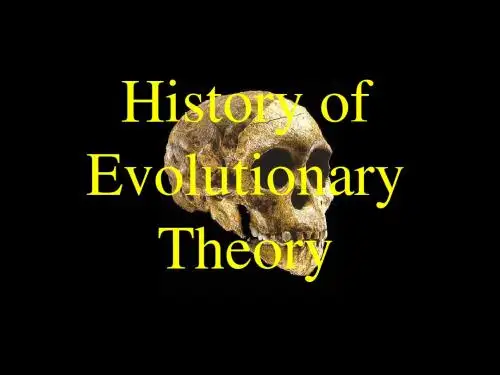
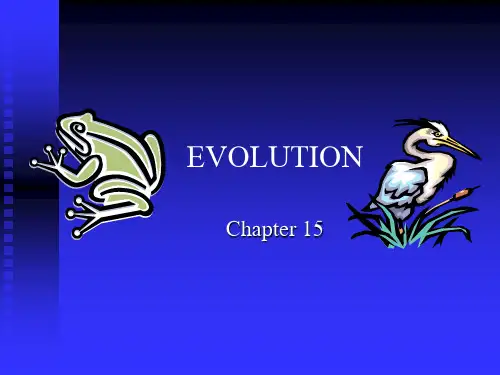
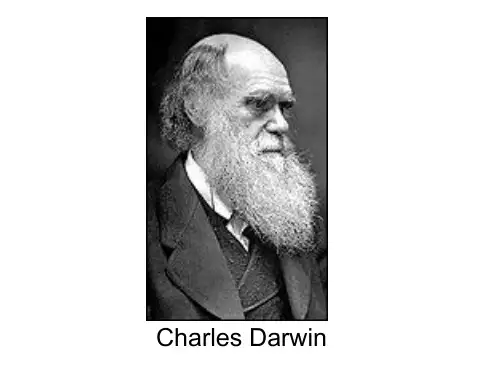
人类起源.英文作文英文:The origin of human beings is a topic that has fascinated scientists, researchers, and the general public for centuries. There are various theories and hypotheses about the origins of humans, and it is a complex and multifaceted subject that continues to be studied and debated.One of the most widely accepted theories about human origins is the theory of evolution. According to this theory, humans and other primates share a common ancestor, and over millions of years, various evolutionary processes led to the development of modern humans. This theory is supported by a large body of evidence from fields such as paleontology, genetics, and anthropology.Another theory about human origins is the "out of Africa" theory, which suggests that modern humansoriginated in Africa and then migrated to other parts ofthe world. This theory is supported by genetic evidence, which indicates that the genetic diversity of modern humans is highest in African populations.There are also cultural and religious beliefs about the origins of humans. For example, many creation myths and religious texts offer explanations for how humans came to exist. These beliefs often vary widely between different cultures and can be a source of great debate and discussion.In addition to these theories and beliefs, there is ongoing research into the origins of humans, including the study of ancient hominin fossils, genetic analysis of modern and ancient human populations, and the investigation of early human behaviors and societies.Overall, the origins of humans are a complex and multifaceted subject, and our understanding of this topic continues to evolve as new evidence and research findings come to light.中文:人类起源是一个几个世纪以来一直吸引着科学家、研究人员和普通大众的话题。
人类的起源英文作文英文:The origin of humans is a fascinating topic that has been studied for centuries. There are various theories and hypotheses about how humans came to be, but the most widely accepted one is the theory of evolution.According to this theory, humans evolved from apes over millions of years. This process of evolution was driven by natural selection, which means that the individuals with the most advantageous traits were more likely to survive and reproduce. Over time, these advantageous traits became more common in the population, leading to the development of new species.One of the key pieces of evidence for evolution is the fossil record. Fossils are the remains of ancient organisms that have been preserved in rocks. By studying the fossils of our ancestors, scientists have been able to trace theevolution of humans back millions of years.Another piece of evidence for evolution is the genetic similarities between humans and other primates. For example, humans share over 98% of their DNA with chimpanzees. This suggests that humans and chimpanzees share a commonancestor that lived millions of years ago.Overall, the theory of evolution provides a compelling explanation for the origin of humans. While there are still many unanswered questions, the evidence suggests that humans evolved from apes over millions of years through the process of natural selection.中文:人类的起源是一个令人着迷的话题,已经被研究了几个世纪。
达尔文进化论英文作文英文:Darwin's theory of evolution is one of the most important scientific theories in history. It proposes that all species of life have descended from a common ancestor through a process of natural selection. This means that the organisms that are best adapted to their environment are more likely to survive and reproduce, passing on their advantageous traits to their offspring. Over time, these advantageous traits accumulate and can lead to the development of new species.One of the key examples of natural selection in action is the peppered moth. Before the Industrial Revolution, most peppered moths had light-colored wings, which helped them blend in with the light-colored trees they lived on. However, as pollution from factories darkened the trees, the darker-colored moths became more difficult for predators to spot and began to thrive. This led to a shiftin the moth population, with the darker moths becoming more common.Another example is the evolution of the giraffe's long neck. It was once thought that giraffes evolved long necksin order to reach leaves on tall trees. However, recent research suggests that the long necks actually evolved as a result of sexual selection. Male giraffes with longer necks are better able to compete for mates, and their offspring inherit their longer necks.Overall, Darwin's theory of evolution has had aprofound impact on our understanding of the natural world.It has helped us to explain the diversity of life on Earth and has provided a framework for studying how species change over time.中文:达尔文的进化论是历史上最重要的科学理论之一。
生物进化过程的作文英文回答:Evolution is a fascinating process that has shaped the diversity of life on Earth over billions of years. It is driven by natural selection, a mechanism proposed by Charles Darwin in his theory of evolution. Through natural selection, certain traits become more or less common in a population over time, depending on their ability to enhance survival and reproduction.For example, let's consider the evolution of thegiraffe's long neck. In the past, giraffes with slightly longer necks were able to reach higher leaves on trees, giving them a better chance of survival and reproduction. As a result, their offspring inherited this advantageous trait and passed it on to future generations. Over time, this led to the evolution of giraffes with even longer necks, as those with shorter necks were less successful in finding food and mating partners.Another example is the evolution of the peppered mothin England during the industrial revolution. Prior to the industrial revolution, most peppered moths had a light coloration that helped them blend in with the lichen-covered tree bark. However, as pollution from factories darkened the tree bark, the lighter-colored moths became more visible to predators. In this case, the darker-colored moths had a higher chance of survival and reproduction, leading to an increase in their population. This is a classic example of how natural selection can drive the evolution of a species in response to changes in the environment.中文回答:进化是一个令人着迷的过程,它在地球上亿万年间塑造了生命的多样性。